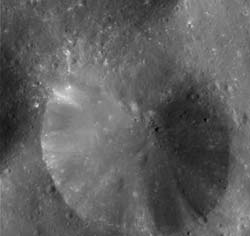Crater on Phoebe in close-up

Credits: NASA/JPL/Space Science Institute
This amazing high-resolution image of Phoebe’s pitted surface was taken very near the closest approach by the NASA/ESA/ASI Cassini-Huygens spacecraft.
It shows a crater with a diameter of 13 kilometres and a debris-covered floor. Part of another crater of similar size is visible at left, as is part of a larger crater at the top and many scattered smaller craters.
The radial streaks in the crater are due to downslope movements of loose fragments from impact ejecta (material thrown out by impacts). Also seen are boulders ranging from about 50 to 300 metres in diameter.
These ’building-sized’ rocks may have been excavated by large impacts, perhaps from some other region of Phoebe rather than the craters seen here. There is no visible evidence for layering of ice and regolith (or a hardened crust, or mantle) in this region, as on other parts of this moon.
Some of the relatively bright spots are from small impacts that excavated bright material from beneath the dark surface. Images like this provide information about impact and regolith processes on Phoebe.
The Cassini-Huygens mission is a co-operative project of NASA, ESA and the Italian Space Agency.
Media Contact
More Information:
http://www.esa.int/SPECIALS/Cassini-Huygens/SEMBZ33VQUD_0.htmlAll latest news from the category: Physics and Astronomy
This area deals with the fundamental laws and building blocks of nature and how they interact, the properties and the behavior of matter, and research into space and time and their structures.
innovations-report provides in-depth reports and articles on subjects such as astrophysics, laser technologies, nuclear, quantum, particle and solid-state physics, nanotechnologies, planetary research and findings (Mars, Venus) and developments related to the Hubble Telescope.
Newest articles

Bringing bio-inspired robots to life
Nebraska researcher Eric Markvicka gets NSF CAREER Award to pursue manufacture of novel materials for soft robotics and stretchable electronics. Engineers are increasingly eager to develop robots that mimic the…

Bella moths use poison to attract mates
Scientists are closer to finding out how. Pyrrolizidine alkaloids are as bitter and toxic as they are hard to pronounce. They’re produced by several different types of plants and are…

AI tool creates ‘synthetic’ images of cells
…for enhanced microscopy analysis. Observing individual cells through microscopes can reveal a range of important cell biological phenomena that frequently play a role in human diseases, but the process of…





















